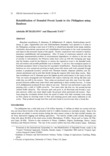Rehabilitation of Denuded Forest Lands in the Philippines using Bamboos
JIRCAS international symposium series
| ISSN | 13406108 |
|---|---|
| NII recode ID (NCID) | AA1100908X |

Full text
intlsymp-1_72-77.pdf265.96 KB
Bamubusa arundinacea, B. blumeana, B. philippinensis, B. vu!garis, Dendrocalamus merrillianus,D. asper, Gigantochloa levis and Schizostachyum lumampao were planted in 14 sites in the Philippines covering a total area of 2,100 ha to rehabilitate denuded forest lands, stabilize riverbanks, demonstrate appropriate soil rehabilitation technologies to the rural communities and improve the economic status of the pepole. Farmer cooperators were trained in bamboo plantation estabilshment and management. After 15 years of continuous research with the seemingly insurmountable problem of environmental degradation, in relation to the low rate of success in reforestation, the Filipinos today have come up with the intriguing new hope that the bamboo could be the lifesaver to restore the vegetative cover to the denuded lands, halt soil erosion and provide profitable crop to farmers. It can be a key ecological species to facilitate succession which is important for successful rehabilitation. Results showed that the bamboos are now extensively growing in study areas with stones and rocks exposed through erosion, in grasslands formerly covered with Themeda triandra, Imperata cylindrica and Saccharum spontaneum and in soils that shrink during dry seasons with many deep cracks. Bambusa arundinacea and B. blumeana gave the highest growth performance in the types of soils. They are easily propagated and maintained and require watering only during the first year while they are still in the nursery. New culms are produced year after year from the underground rhizomes unlike most trees which need replanting to obain another harvest. A clump of B. philippinensis produced 20 new culms in one year. Harvest was performed 3 years after planting with a yield of 15,000 culms/ha. Two years after the first cut, the second harvest yielded 25,000 culms/ha. The rhizomes and roots grew in all directions and formed a complex network within one meter depth under the ground which prevented soil erosion. Bamboos along the riverbanks slowed down the speed of water with their extended roots acting as filter plants by allowing water to flow and retaining gravel and coarse sediments in the culms. They produced enough leaf litter and were found to survive even after a forest fire.
| Creator | Adelaida BUMARLONG Hisayoshi YAGI |
|---|---|
| Publisher | Japan International Research Center for Agricultural Sciences |
| Available Online | |
| Issue | 1 |
| spage | 72 |
| epage | 77 |
| Language | eng |
